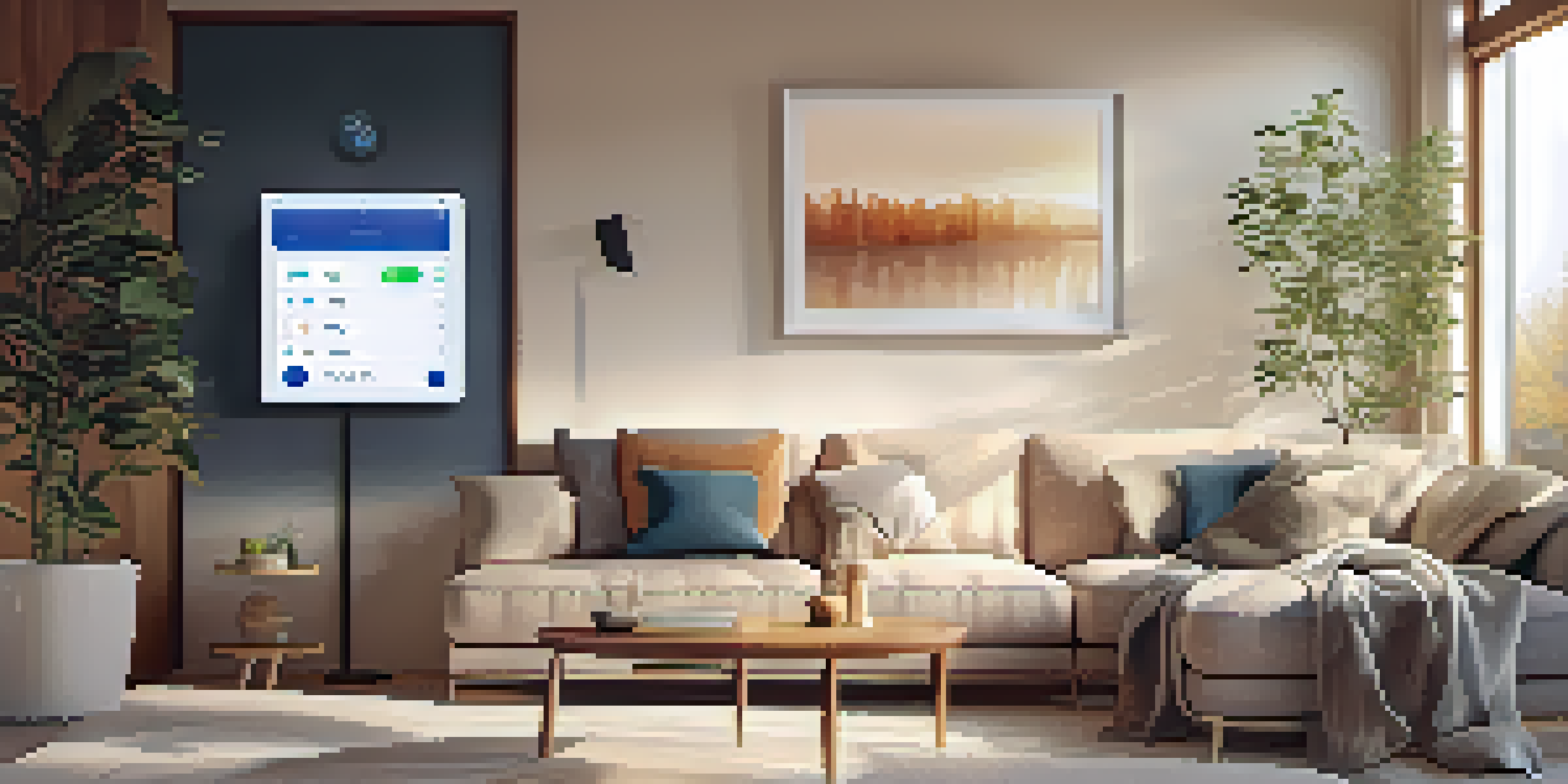Combining Home Automation with Smart Thermostats

Understanding Smart Thermostats and Their Benefits
Smart thermostats are advanced devices that allow you to control your home's heating and cooling systems remotely. They learn your daily routines and preferences, adjusting the temperature accordingly to maximize comfort and energy efficiency. By using features like scheduling and geofencing, they can lower your energy bills while keeping your home cozy.
The greatest energy solution we can find is to use less energy in the first place.
These devices often connect to Wi-Fi, enabling you to manage settings via a smartphone app. This means that even if you're away from home, you can easily adjust the temperature or receive alerts about unusual conditions. Imagine returning from a long day to a perfectly heated home, thanks to your smart thermostat’s pre-programmed settings.
Moreover, smart thermostats can provide valuable insights into your energy usage. They can track patterns over time, helping you make informed decisions about your energy consumption. This not only saves you money but also contributes to a more sustainable lifestyle.
Home Automation: A Seamless Integration for Convenience
Home automation refers to the technology that allows you to control various devices in your home from a single interface. This could include lights, security cameras, and appliances, all working together to enhance your daily life. By integrating smart thermostats into your home automation system, you create a more cohesive living environment.

Imagine a scenario where your smart thermostat communicates with your smart lighting. As the sun sets, the lights gradually brighten, while the thermostat adjusts the temperature to ensure a comfortable atmosphere. This level of automation not only enhances your comfort but also contributes to energy efficiency by optimizing usage.
Smart Thermostats Boost Energy Savings
These devices learn your habits to optimize heating and cooling, significantly lowering energy bills.
Furthermore, home automation can increase your home's security. For example, when you leave home, your smart thermostat can automatically adjust the temperature to save energy, while your security system activates. This creates a convenient, worry-free experience as you know everything is taken care of.
How Smart Thermostats Improve Energy Efficiency
One of the standout features of smart thermostats is their ability to enhance energy efficiency. By learning your habits, these devices can adjust heating and cooling based on when you're home or away. This means they don’t waste energy heating or cooling an empty house, which can significantly lower your utility bills.
Technology is best when it brings people together.
For instance, if you typically leave for work at 8 AM, your thermostat will begin to lower the temperature just before you leave. Similarly, it can begin warming your home shortly before you return, ensuring comfort without unnecessary energy expenditure. It's like having a personal energy assistant that knows exactly how to optimize your home's environment.
Moreover, many smart thermostats provide insights into your energy consumption patterns. This data can help you identify areas where you might be wasting energy, empowering you to make smarter choices and further improve efficiency. Over time, even small adjustments can lead to substantial savings.
Integrating Smart Thermostats into Home Automation Systems
Integrating your smart thermostat into a home automation system is relatively straightforward. Most modern smart thermostats are compatible with popular home automation platforms, such as Amazon Alexa, Google Assistant, and Apple HomeKit. This allows you to control your thermostat with simple voice commands or through a centralized app.
For example, you can say, 'Hey Google, set the living room to 72 degrees,' and your thermostat will respond instantly. Additionally, you can create routines that trigger multiple actions at once. Imagine saying, 'Goodnight,' and having your thermostat lower the temperature, your lights dim, and your security system arm—all in one go.
Home Automation Enhances Comfort
Integrating smart thermostats with home automation creates a seamless, comfortable living environment.
This level of integration not only simplifies daily routines but also enhances overall comfort and security. It transforms your home into a smart ecosystem where devices work together harmoniously, making everyday tasks easier and more enjoyable.
The Role of Sensors in Smart Home Automation
Sensors play a crucial role in the effectiveness of smart thermostats and home automation. Temperature sensors can detect changes in the environment, allowing your thermostat to make real-time adjustments for maximum comfort. For example, if a room gets particularly warm from sunlight, the thermostat can cool it down without you having to lift a finger.
In addition to temperature sensors, motion sensors can enhance the system's efficiency. By detecting whether someone is present in a room, your thermostat can adjust accordingly—saving energy when rooms are unoccupied. This kind of responsiveness contributes to a more comfortable living space and reduces energy waste.
Moreover, smart home systems can integrate various types of sensors, such as humidity and air quality sensors, to further optimize your indoor environment. With this comprehensive data, your smart thermostat can create a truly personalized atmosphere that adapts to your needs and preferences.
User-Friendly Features of Smart Thermostats
One of the biggest advantages of smart thermostats is their user-friendly features that make them accessible to everyone. Most models come with intuitive mobile apps that allow you to adjust settings, set schedules, and monitor energy usage—all from the palm of your hand. This convenience means you can control your home's climate even when you're not there.
Additionally, many smart thermostats offer voice control capabilities. If you're busy cooking in the kitchen or relaxing on the couch, simply asking your virtual assistant to make adjustments can be a game-changer. This hands-free functionality adds a level of convenience that traditional thermostats simply can’t match.
Sensors Optimize Home Efficiency
Various sensors allow smart thermostats to make real-time adjustments, improving comfort and reducing energy waste.
Lastly, the installation process for smart thermostats has become increasingly simple. Many devices come with easy-to-follow instructions and online tutorials, making it possible for even the least tech-savvy homeowners to set them up. This accessibility encourages more people to embrace smart home technology and enjoy its benefits.
The Future of Smart Thermostats and Home Automation
As technology continues to evolve, the future of smart thermostats and home automation looks promising. We can expect even more advanced features, such as improved artificial intelligence that learns from user behavior to optimize energy settings better. This evolution will likely lead to smarter homes that can anticipate needs and respond accordingly.
Moreover, developments in renewable energy integration will transform how we think about smart home systems. Imagine a smart thermostat that can coordinate with solar panels to use energy more efficiently, charging batteries during the day and optimizing usage during peak times. This could lead to significant cost savings and a lighter environmental footprint.

Ultimately, the integration of smart thermostats within broader home automation systems will create a more comfortable, efficient, and sustainable living environment. As homeowners increasingly seek solutions that simplify their lives while being environmentally conscious, smart technology will continue to play a vital role in shaping our future.